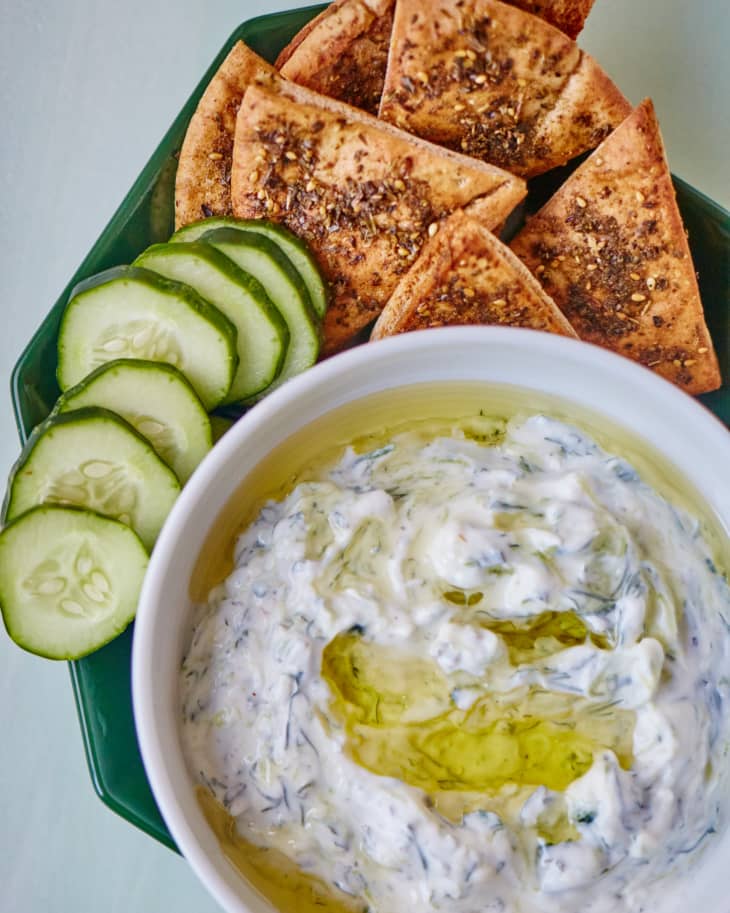How To Make Cool, Creamy Greek Tzatziki Sauce

Makes1 1/2 cups
What do salsa, hummus, and tzatziki all have in common? They are all culinary chameleons that can be either a dip, a sauce, or a condiment at any given meal. Each of these dips pair equally well with grilled meats, roasted vegetables, and toasted bread. You can put them on a sandwich and even serve them as a party dip.
Tzatziki sometimes moonlights as yogurt-cucumber sauce or as that dill dip they serve at your favorite Greek restaurant, but chances are high you’ve enjoyed this cool, creamy, herby sauce before. And like salsa and hummus, it’s a good idea to keep a batch of tzatziki in your fridge at all times.
What Is Tzatziki?
Tatziki is a yogurt-based sauce with cucumber, garlic, and fresh herbs that is also served as a dip. Greek in origin, tzatziki is often served on sandwiches, alongside grilled meats or kebabs (especially lamb), and as a dip for pita or fresh vegetables.
Like salsa or hummus, tzatziki isn’t hard to make at home. In fact, two key steps will make this recipe your best batch yet and show you how truly versatile this sauce can be. The first is finding the right yogurt and the second is selecting and preparing the cucumber for the sauce.
The Best Yogurt for Tzatziki Sauce
A Greek sauce requires Greek yogurt, right? This thick strained yogurt wasn’t always as widely available as it is today, so you’ll often see tzatziki recipes calling for straining plain yogurt overnight to make a thicker, richer base for the dip. By using store-bought yogurt, we cut out the straining step and get right to making the dip.
If classic plain yogurt is what you’ve got on hand, you can strain it overnight in cheesecloth, or use a 50/50 mixture of the looser yogurt and sour cream in place of the Greek yogurt called for here.
Grate and Squeeze Your Cucumber for Better Tzatziki
Cucumbers are full of water, which is no doubt what makes then so refreshing. Unfortunately once mixed with acidic ingredients like yogurt and lemon juice, cucumber starts releasing moisture — making a once-creamy sauce, well, watery. The trick for preventing this is to remove the water from the cucumber before adding it to the sauce. Grate your cucumber on the large holes of a box grater onto a clean, lint-free kitchen towel. Then pick up the sides of the towel and make a tight bundle around the cucumber. Squeeze out as much moisture as possible from the cucumber. The cucumber juice can be collected and saved. Add to lemonade or a gin cocktail.
I prefer to use English cucumbers rather than plump, regular cucumbers for tzatziki. English cucumbers have a thin skin (no peeling required) and don’t require seeding. If you’ve got a garden full of cucumbers or can’t find English cukes, peel and seed your cucumber before grating.
Did you know? The Best Place for Storing Cucumbers
Using and Storing Tzatziki Sauce
Prepare your tzatziki at least an hour before you plan on serving it. The flavor gets even better overnight, so if you’ve got the time and forethought, throw this dip together the night before you plan to serve it.
Once you master making tzatziki at home, you’ll find yourself reaching for it for everything from sandwiches to tacos. Here are a few of my favorite ways to eat it.
- As a dip with pita and vegetables
- In place of mayonnaise on any sandwich
- As a sauce on cooked salmon
- As a marinade for chicken thighs before grilling
- On turkey burgers
- Tossed with roasted vegetables for a stunning side dish
- Instead of mayonnaise on potato salad
- As a dip for chips
- As a salad dressing
Some of Kitchn’s Favorite Tzatziki-Loving Recipes
How To Make Cool, Creamy Greek Tzatziki Sauce
Makes 1 1/2 cups
Nutritional Info
Ingredients
- 1 cup
plain Greek yogurt
- 1/4 cup
freshly squeezed lemon juice (from 2 large lemons)
- 1/4 cup
coarsely chopped fresh dill fronds
- 1/4 cup
fresh mint leaves, finely chopped
- 2 tablespoons
extra-virgin olive oil
- 1 clove
garlic, minced
- 1 teaspoon
kosher salt
- 1/2 teaspoon
freshly ground black pepper
- 1
medium English cucumber
Equipment
Measuring cups and spoons
Medium bowl
Chef's knife
Cutting board
Box grater
Clean, lint-free kitchen towel
Rubber spatula
Instructions
Season the yogurt: Place the yogurt, lemon juice, dill, mint, oil, garlic, salt, and pepper in a medium bowl and stir to combine.
Grate the cucumber: Lay a clean, lint-free kitchen towel down on a cutting board and grate the cucumber on the large holes of a box grater onto the towel.
Squeeze excess moisture from the cucumber: Remove the grater and gather the towel around the grated cucumber to form a bundle. Working over the sink (or a glass or bowl if you want to retain the juice), wring the towel to remove as much liquid from the cucumber as possible.
Fold the cucumber into the yogurt mixture: Transfer the strained cucumber to the yogurt mixture and fold with a rubber spatula to combine.
Chill and serve: Cover and refrigerate for at least 1 hour before serving.
Recipe Notes
Storage: Tzatziki can be stored in an airtight container in the refrigerator for up to 5 days.
